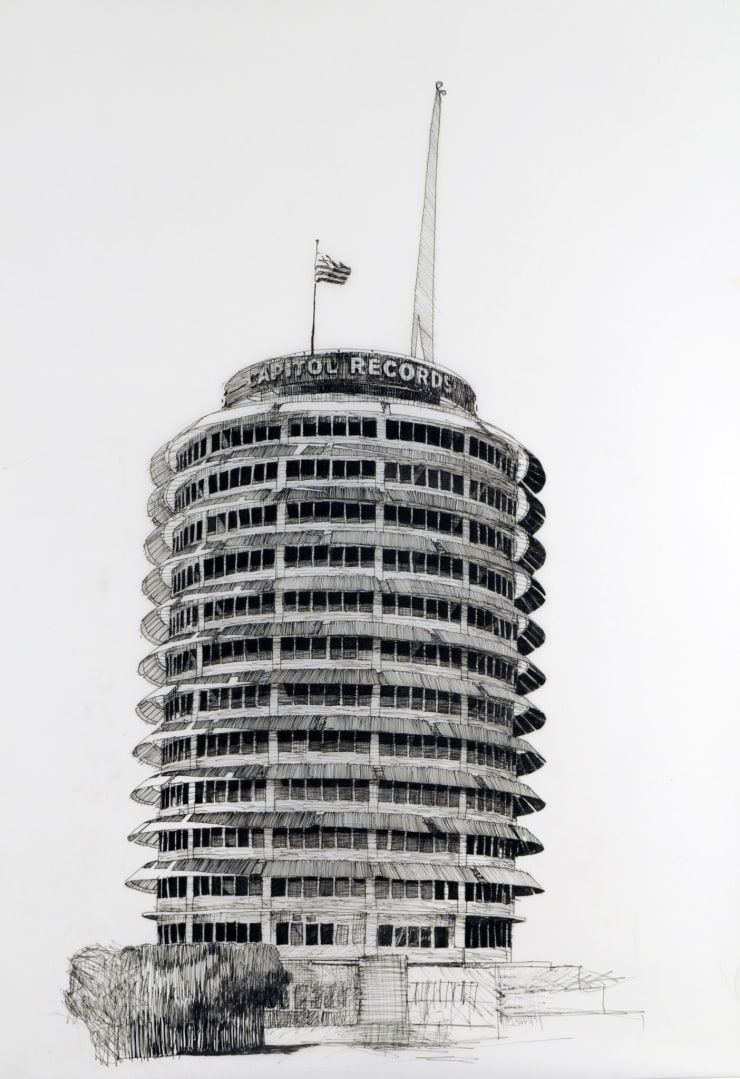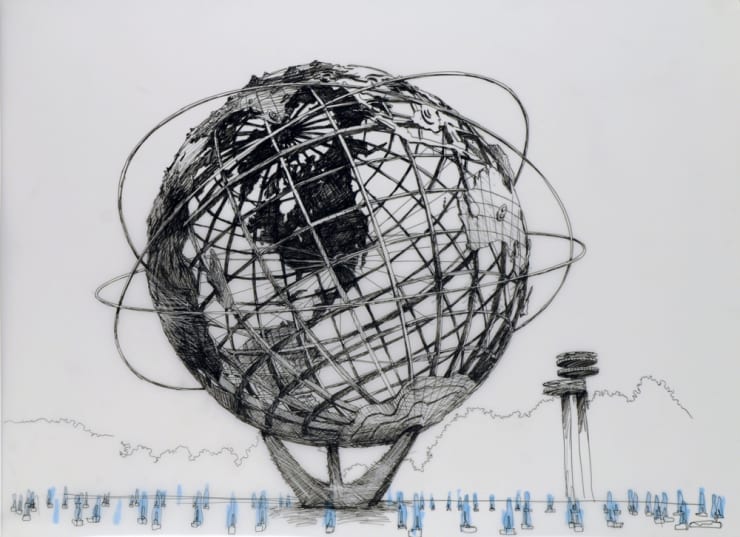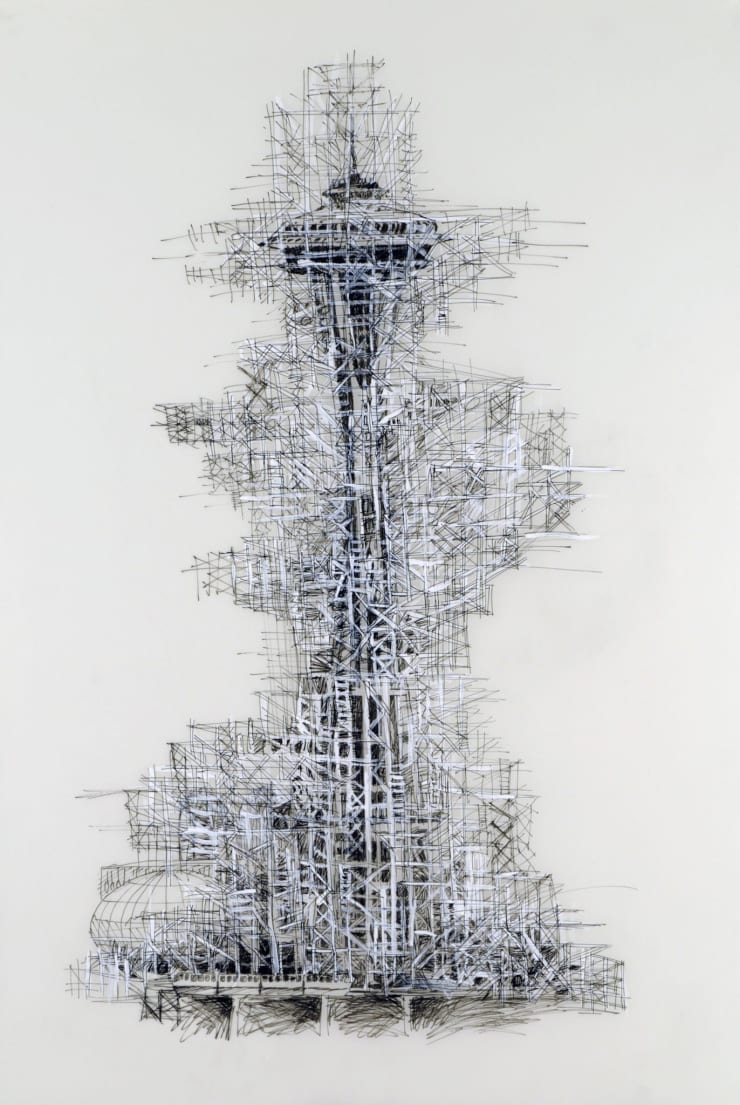Deborah Aschheim: Nostalgia for the Future
“The future is but the obsolete in reverse” -- Vladimir Nabokov
Edward Cella Art & Architecture announces a solo exhibition of new work by Los Angeles based artist Deborah Aschheim. Entitled Nostalgia for the Future, the exhibition presents Aschheim’s singular drawings and architectural installations of eccentric modernist landmarks of Southern California that embody a discourse about memory, place, and the unfulfilled promises of our future. This is Aschheim’s first exhibit with Edward Cella Art & Architecture.
“The future is but the obsolete in reverse” -- Vladimir Nabokov
Edward Cella Art & Architecture announces a solo exhibition of new work by Los Angeles based artist Deborah Aschheim. Entitled Nostalgia for the Future, the exhibition presents Aschheim’s singular drawings and architectural installations of eccentric modernist landmarks of Southern California that embody a discourse about memory, place, and the unfulfilled promises of our future. This is Aschheim’s first exhibit with Edward Cella Art & Architecture.
Aschheim’s art reflects her passion for L.A.’s quirky modernist icons that are quickly vanishing in front of our eyes like treasured family members. These structures, formerly the symbols of Southern California’s utopian dreams, are now forlorn and crumbling commercial towers, buildings and centers. Recent public controversies surrounding the future of Minoru Yamasaki’s Century Plaza Hotel and the effort to stabilize Welton Becket’s Theme Building at the Los Angeles International Airport manifest for Aschheim as a tragic and incessant sense of obsolescence.
Aschheim states, “When I was growing up, the future was limitless possibility, jet-age, space-age, techno-utopia. ‘Modern’ meant new. Now, modern means old and the future I grew up with seems dated, irresponsible, and obsolete.” To Aschheim, iconic post-war era architecture like the Capital Records Building or architect Peter J. Holdstock’s Fine Arts Building and Science Hall at Ambassador College in Pasadena, are for the most part treated as unacclaimed monuments of a distant era, a visual gulf between “then” and “now”.
Aschheim’s work focuses on the individual characters of her sitters — the buildings themselves and their current users — in flowing and energetic pen and ink on Dura-lar. Developed over time through numerous visits to each site, Aschheim’s architectural “portraits” are also informed by documentary research on the architects, designers and engineers, whose ideas and dreams are captured in these monumental creations. Installed in groupings across the Gallery, the drawings reveal multiple points of perspective from Aschheim’s eye, memory and hand as she attentively yet wistfully depicts the overall composition and details that define and characterize each building she has selected. At the intersection of two worlds – the elusive, private space of memory and the contested space of bodies and the built environment – Aschheim attempts to inscribe the faded optimism and loss encoded in each building; suggesting her own changed relationship to time.
Aschheim’s recent work includes solo exhibits at the Pasadena Museum of Art, Laumeier Sculpture Park in St. Louis, and the Mattress Factory Museum in Pittsburgh. Recent group exhibitions include the Museum of Jurassic Technology, the Sun Valley Center for the Arts and the Armory Center for the Arts, the Austin Museum, and the Weatherspoon Museum. Commissions include permanent public artworks for the San Jose International Airport and the City of Sacramento. She is currently the Hellman Visiting Artist at the Memory and Aging Center in the Department of Neurology at UC San Francisco.
EXHIBITION PROGRAMS
In Conversations: Meg Linton and Tom Leeser with Deborah Aschheim
Saturday, September 25, 2010 / 4:00 PM
Join Meg Linton and Tom Leeser as they discuss Nostalgia for the Future with artist Deborah Aschheim. Leeser and Linton bring their unique perspectives as curator and artist, respectively, in opening dialogues about memory, modernism, and our conceptions of the misremembered future. Both Leeser and Linton have included Aschheim’s work in recent exhibitions at the Ben Maltz Gallery and the Museum of Jurassic Technology.
Meg Linton is the Director of Galleries and Exhibitions, Ben Maltz Gallery, Otis College of Art and Design in Los Angeles. Over the last sixteen years, she has organized hundreds of solo and group exhibitions and published dozens of catalogues. She received degrees from the University of California at Irvine and California State University, Fullerton, and completed the prestigious Museum Leadership Program at The Getty Leadership Institute. Her previous curatorial positions include the Santa Barbara Contemporary Arts Forum and University Art Museum at California State University, Long Beach.
Tom Leeser is the Director of the Center for Integrated Media at CalArts and has been active in the field of art and technology for over twenty years as a digital media artist, writer, educator, and curator. A graduate of the San Francisco Art Institute, his work has been exhibited at MassMOCA, Santa Monica Museum of Art, the Kitting Factory, and film and video festivals nationwide.
Norman Klein and Margo Bistis
Baroque Modernism: An Uneasy Alliance of Power and Culture
The Odd Poetics of Modernist Cities in the Midst of Their Own Erasure (1960-75)
Saturday, October 16, 2010 / 2:00 PM
All buildings speak to power, simply in the way that they are designed and constructed. The process of putting up a building is a narrative that leaves traces. Join Norman Klein and Margo Bistis as they discuss a collective unconscious of architecture and cities, and what modernist buildings can tell us about our catastrophes today.
Margo Bistis is a European cultural historian, independent curator, and teaches in the School of Critical Studies at California Institute of the Arts. Her publications include essays on Henri Bergson, modernism, and caricature. In 2003, she assisted in the curating of Comic Art: The Paris Salon in Caricature at the Getty Research Institute.
Norman M. Klein is a critic, urban and media historian, novelist, and teaches in the School of Critical Studies at California Institute of the Arts. His publications include The History of Forgetting: Los Angeles and the Erasure of Memory; The Vatican to Vegas: The History of Special Effects; Freud in Coney Island and Other Tales; and the database novel Bleeding Through: Layers of Los Angeles, 1920-86. His work centers on the relationship between collective memory and power, from special effects to cinema to digital theory, usually set in urban spaces; and often on the thin line between fact and fiction; about erasure, forgetting, scripted spaces, the social imaginary.
-
 Deborah Aschheim, Capitol No. 3 (Windows Facing Vine), 2010
Deborah Aschheim, Capitol No. 3 (Windows Facing Vine), 2010 -
 Deborah Aschheim, Capitol (Only Clear Memory Lonely Year in Hollywood), 2009
Deborah Aschheim, Capitol (Only Clear Memory Lonely Year in Hollywood), 2009 -
 Deborah Aschheim, Unisphere (I See in My Mind Mom in Front of it looking like JackieKennedy), 2009
Deborah Aschheim, Unisphere (I See in My Mind Mom in Front of it looking like JackieKennedy), 2009 -
 Deborah Aschheim, Unisphere No.3, 2010
Deborah Aschheim, Unisphere No.3, 2010 -
 Deborah Aschheim, Tent of Tomorrow Number 3, 2010
Deborah Aschheim, Tent of Tomorrow Number 3, 2010 -
 Deborah Aschheim, World's Fair, 2010
Deborah Aschheim, World's Fair, 2010 -
 Deborah Aschheim, World's Fair, 2010
Deborah Aschheim, World's Fair, 2010 -
 Deborah Aschheim, Tent of Tomorrow (We Rode the Subway All the Way to Flushing Corona Meadows), 2009
Deborah Aschheim, Tent of Tomorrow (We Rode the Subway All the Way to Flushing Corona Meadows), 2009 -
 Deborah Aschheim, Needle (In My Dream Erased by a Cloud of Scaffolding, Receding into the Overcast Seattle Sky), 2009
Deborah Aschheim, Needle (In My Dream Erased by a Cloud of Scaffolding, Receding into the Overcast Seattle Sky), 2009 -
 Deborah Aschheim, Encounter, 2009
Deborah Aschheim, Encounter, 2009 -
 Deborah Aschheim, Century, 2010
Deborah Aschheim, Century, 2010















